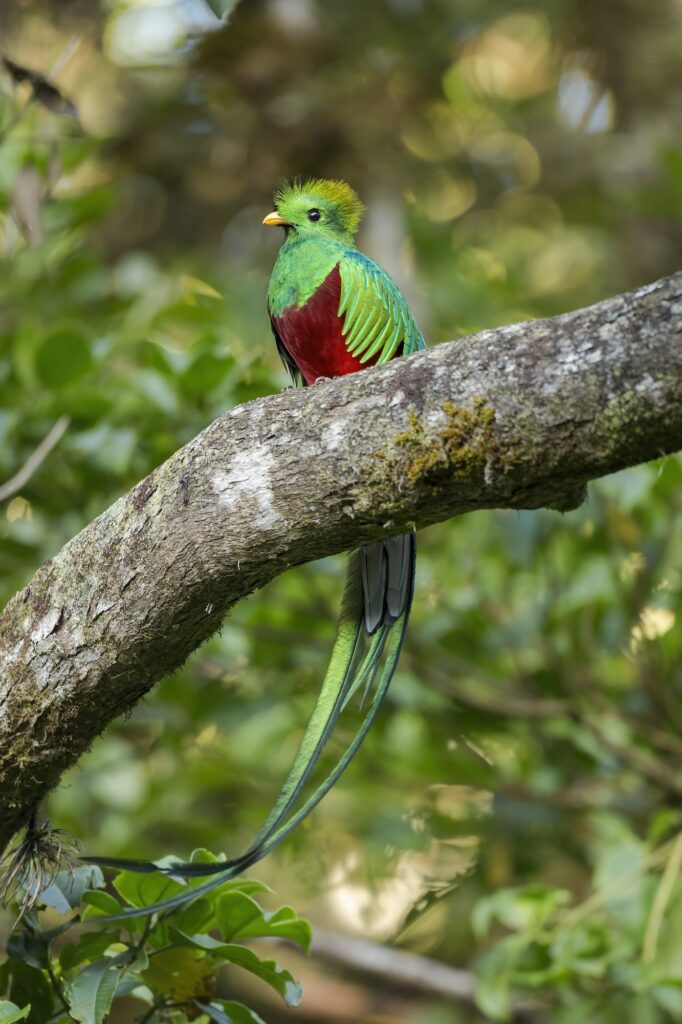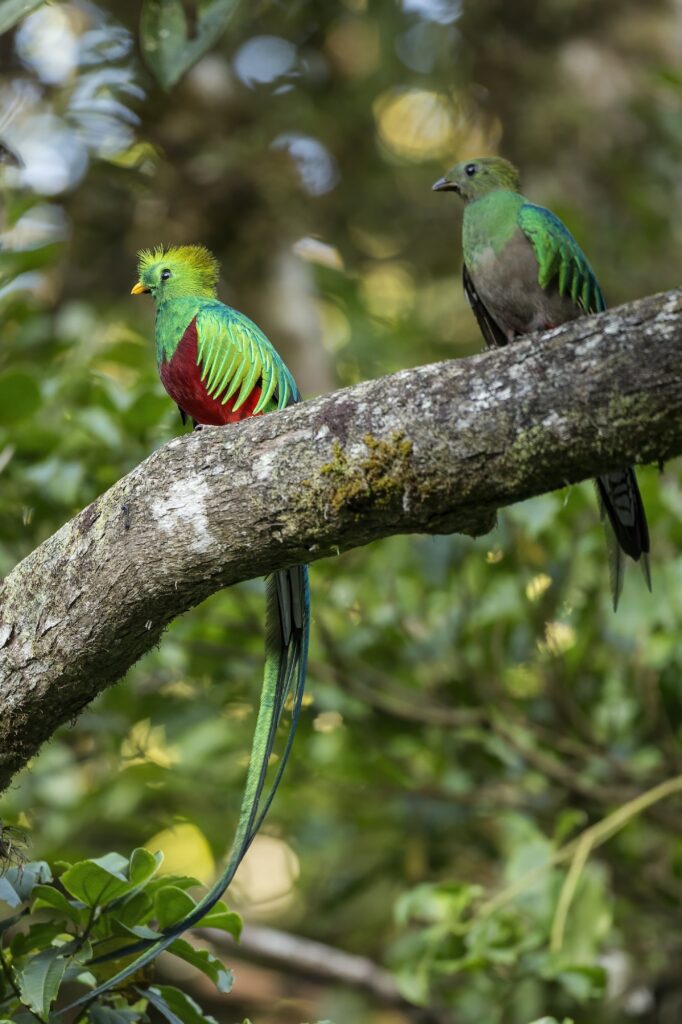The quetzal, symbol of freedom, emblem of Guatemala and undisputed star of Latin American birds, is on the verge of extinction. It is on the Red List of Threatened Species of the IUCN, the world authority on the protection of the natural environment. Logging, livestock farming and the illegal trade in feathers destroy the natural habitat of the pharomachrus mocinno. How does Costa Rica protect the resplendent quetzal from extinction? Cloud forests and canopy welcome and nourish it. Concrete observation and nesting programs support this favourable but insufficient environment. Because we do not abandon a symbol of freedom, a divinity, a legend. Listen to his famous koy-koy and see if he can still be saved.

Resplendent quetzal preserved by the Costa Rican natural environment
Suitable habitat in cloud forests
Pharomachrus mocinno (from trogonidae family) lives in tropical, humid woodland and mountain areas. In Guatemala, reserves exist, but are too small on the surface. We recall that its rate of deforestation is one of the most dramatic in the American continent (34% in 20 years). Oil palm, rubber and breeding has destroyed the vegetation.
The quetzal lives in the canopy in search of the tallest trees such as ficus, brosimum, cecropia, and guanacaste. The density of epiphytes (layers of overlapping foliage) is its habitat.
Costa Rica’s numerous reforestation actions play a predominant role in safeguarding the quetzal. In 30 years, this country has doubled its wooded area.
Trunks high enough for nesting
In Costa Rica, nesting takes place between March and June and can cause two broods. Birds prepare their nests at a height of 15 meters (sometimes 25 meters) in a tree branch excavation, such as those in the Costa Rican canopy.
🦜️ Did you know?
Its typical call differs from its trogon cousins. Its cry is “soft, deep, full and very powerful,” according to animaldiversity.org. The usual “koy-koy” turns into “weec-weec” when he tries to gather. In the love season, it is through a plaintive sound that he calls its.

Abundant food thanks to Costa Rican biodiversity
The richness of the Costa Rican ecosystems provides the food that the resplendent quetzal needs. Fruits of lauraceae, lizards, insects, small frogs, and snails make up its daily menu.
Costa Rica’s concrete actions to save the sacred bird
The KABEK project in the Cerro de la Muerte
The project «KABEK – Pro-quetzal families» was born in 2010 in the Cerro de la Muerte, precisely where the bird lives. The program consists in helping it survival in the winter and boost the tourism economy in low season. Local families join the guides to inform visitors.
This collaborative work leads to sustainable activity with implications for education. Respect of the biodiversity and reforestation expands nesting areas. In 2018, a couple of quetzals even settled in an artificial nest. The number of observation points is getting higher.
The Quetzal Education and Investigation Centre (QERC) in Dota
Located in San Gerardo de Dota, this university subsidiary works on biodiversity, sustainable development, social responsibility and investigation of the quetzal. At 2,200 meters above sea level in the cloud forest of the Talamanca Cordillera, the QERC has 20 km of trails and 9,800 square meters of private reserve. Dr Leo Finkenbinder’s successor researchers are investigating the bird’s habitat, diet and life cycle.
Quetzal valley in the province of San José
The Parque Nacional Los Quetzales is located in Dota (San José province) and offers a privileged area for ornithological experience. The cloudy forest supports and protects many endemic species, including our hero.
Executive Decree No. 32981-MINAE of 25 April 2006 initiated this initiative in connection with SINAC (Costa Rica National System of Conservation Areas). This agency of the Ministry of the Environment manages and coordinates natural resource sustainability projects.
Protecting the resplendent quetzal means preserving pre-Columbian culture
A symbol of freedom
Fundamentally, the quetzal can only live in the open air. Indeed, as soon as it is in captivity, it prefers to let itself die. The altitude at which it flies (2000 to 2700 meters) may explain this need for space. It is synonymous with freedom.
This divinity of pre-Columbian civilizations is today the national symbol of Guatemala whose currency is eponymous.
A divinity on Earth
The Aztecs and Mayans worshipped the resplendent quetzal: their god of the air, symbol of goodness and light. He owes this image to his bright and almost supernatural colors. The male wears a blue iridescent green on the throat and chest.
But copper and golden highlights alter its appearance as soon as it sets out in the sun. Scarlet red, blue, grey and green compete for the rest of the plumage, including the 4 thin overlying coverts.
It has black feathers and a yellow beak.
The male’s emerald and turquoise blue feathers, coloured by melanin, make him famous. They give it its name nahuatl «quetzali» which means «long tail with bright feathers». The Mayans and Aztecs protected this sacred bird. Moctezuma (16th century Aztec emperor) used his feathers as ornaments for headgear or clothing.
The god Quetzalcoatl, feathered serpent, comes from quetzal and cóatl (snake).
🦜️ Did you know? The female wears a duller coat. Only the male has this tuft of golden green feathers erected on the head.
A bird, hero of legends
Sacred and mythical, it is also the object of legends.
One tells about the final clash between Pedro de Alvarado, conquistador, and Tecun Uman, the last Guatemalan chief. When Alvarado plunged his sword through Tecun’s chest, a quetzal landed on his bloody wound, then flew away with a vermilion stain on his chest. Others think that the Indians sent him to sing when the Spaniards arrived. But, that since that moment the bird remains silent.
Living divinity, allegory of freedom, no matter. The resplendent quetzal is a little beauty that the hand of Man must not endanger. It joins the other treasures that Costa Rica strives to protect, just out of love for nature. By visiting our country, you help fund environmental conservation programs.
I also want to lean about turtles in Costa Rica.
